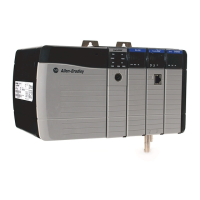Rockwell Automation Publication 1756-RM003N-EN-P - October 2011 661
Function Block Attributes Appendix B
Function Block Responses
to Overflow Conditions
In general, the function block instructions that maintain history do not update
history with ±NAN, or ±INF values when an overflow occurs. Each instruction
has one of these responses to an overflow condition.
Timing Modes
These process control and drives instructions support different timing modes.
There are three different timing modes.
Response 1
Blocks execute their algorithm and check the
result for ±NAN or ±INF. If ±NAN or ±INF, the
block outputs ±NAN or ±INF.
Response 2
Blocks with output limiting execute their
algorithm and check the result for ±NAN or
±INF. The output limits are defined by the
HighLimit and LowLimit input parameters.
If ±INF, the block outputs a limited result.
If ±NAN, the output limits are not used and the
block outputs ±NAN.
Response 3
The overflow condition does not apply. These
instructions typically have a boolean output.
ALMNTCH
DEDTPMUL
DERVPOSP
ESELRLIM
FGENRMPS
HPFSCRV
LDL2SEL
LDLGSNEG
LPFSRTP
MAVESSUM
MAXCTOT
MINCUPDN
MSTD
MUX
HLL
INTG
PI
PIDE
SCL
SOC
BANDOSRI
BNOTRESD
BORRTOR
BXORSETD
CUTDTOFR
D2SDTONR
D3SD
DFF
JKFF
OSFI
DEDT
DERV
HPF
INTG
LDL2
LDLG
LPF
NTCH
PI
PIDE
RLIM
SCRV
SOC
TOT
Timing Mode Description
Periodic Periodic mode is the default mode and is suitable for most control applications. We recommend that you place the
instructions that use this mode in a routine that executes in a periodic task. The delta time (DeltaT) for the instruction is
determined as follows:
If the instruction
executes in a
Then DeltaT equals
Periodic task Period of the task
Event or continuous
task
Elapsed time since the previous execution
The controller truncates the elapsed time to whole milliseconds (ms). For example, if the
elapsed time = 10.5 ms, the controller sets DeltaT = 10 ms.
The update of the process input needs to be synchronized with the execution of the task or sampled 5-10 times faster than
the task executes in order to minimize the sampling error between the input and the instruction.

